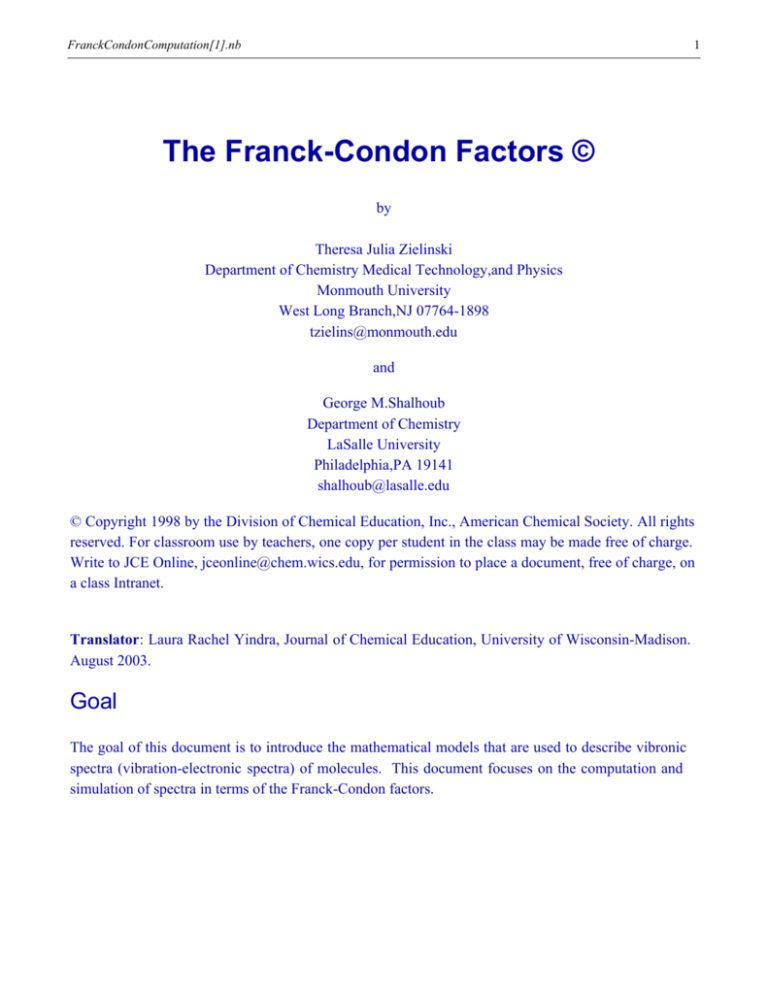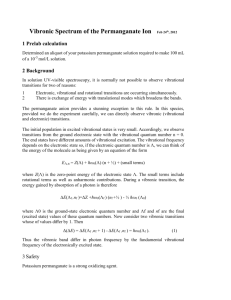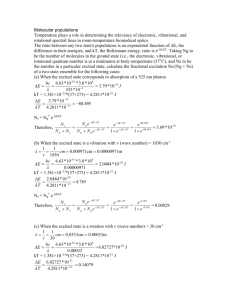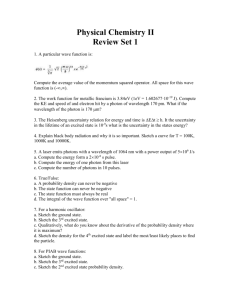
FranckCondonComputation[1].nb
1
The Franck-Condon Factors ©
by
Theresa Julia Zielinski
Department of Chemistry Medical Technology,and Physics
Monmouth University
West Long Branch,NJ 07764-1898
tzielins@monmouth.edu
and
George M.Shalhoub
Department of Chemistry
LaSalle University
Philadelphia,PA 19141
shalhoub@lasalle.edu
© Copyright 1998 by the Division of Chemical Education, Inc., American Chemical Society. All rights
reserved. For classroom use by teachers, one copy per student in the class may be made free of charge.
Write to JCE Online, jceonline@chem.wics.edu, for permission to place a document, free of charge, on
a class Intranet.
Translator: Laura Rachel Yindra, Journal of Chemical Education, University of Wisconsin-Madison.
August 2003.
Goal
The goal of this document is to introduce the mathematical models that are used to describe vibronic
spectra (vibration-electronic spectra) of molecules. This document focuses on the computation and
simulation of spectra in terms of the Franck-Condon factors.
FranckCondonComputation[1].nb
2
Prerequisites
1. Experience with harmonic oscillator wave functions.
2. Moderate skill with Mathematica.
3. Ability to use a full set of orthonormal functions in a linear combination to represent some other
well behaved function over the same interval, e.g. Fourier Series expansions.
4. The introduction to Franck Condon Factors document, FranckCondonBackground.nb should be
studied prior to using this document. The background document also contains a list of prerequisites,
objectives, and preliminary tasks to facilitate learning when using the more quantitative and interactive
material presented here.
Performance Objectives
At the end of this exercise you will be able to:
1. describe the relationship between Franck Condon factors and vibronic spectra;
2. explain the key ideas determining the magnitude of the Franck Condon factors;
3. compute Franck Condon factors;
4. construct a vibronic spectrum for a molecule from a knowledge of the wavelength of the electronic
transition,the number of vibronic peaks,and the relative intensity of the vibronic peaks.
FranckCondonComputation[1].nb
3
Introduction
During a molecular electronic transition from the ground electronic state to an excited electronic state,
the vibrational wave functions of the ground state overlap with the vibrational wave functions of the
excited state. The degree of overlap between the ground and excited state vibrational functions determines the shape and structure of the electronic spectrum that is observed.
In this document we treat the overlap between the ground and excited vibrational states by projecting
the ground state vibrational wave function onto the excited state vibrational wave functions. Mathematically this is equivalent to writing the ground state vibrational wave function as a linear combination of
excited state vibrational wave functions. The harmonic oscillator wave functions will be used for both
the ground state and excited state vibrational energy levels. Both the ground state and excited state
have a full set of wave functions characterized by the quantum numbers, v'' and v'. v" is used to identify the ground state wave functions and v' is used for the excited state wave functions. For iodine the
ground electronic state, v'' = 0, has the greatest population. The interaction of this vibrational level of
the ground electronic state with the excited electronic state via an electronic transition can be with any
of the excited state vibrational energy levels characterized by vibrational quantum number v'. The most
intense interaction will occur when there is a maximum overlap between the ground state vibrational
wave function and an excited state vibrational wave function. Smaller peaks will be observed when the
overlap between the ground state and excited state wave function is less. In general the transition from
v"=0 to v'=0 (commonly called the 0-0 transition) is unlikely because the equilibrium bond length of
the ground state and excited state are expected to be different and this leads to a very small overlap
between the wave functions for these two states.
For determining the degree of interaction between the two electronic states we will use the harmonic
oscillator wave functions because these functions form a complete orthonormal set of functions. The
linear combination process itself is the same as using a Fourier series for some arbitrary function.Furthermore,as when using the Fourier series, weighting factors (the coefficients in the linear expansion) determine how much of each member in the series is used in the expansion that is made for a
particular ground state wave function.These weighting factors are given the symbol 'c[[i]]'.
The square of the coefficients used in the linear combination tells us about the degree of overlap
between the excited state wave functions and the ground state wave function. The square of the coefficients are the Franck Condon factors. The larger the square of the coefficient the more intense the
peak observed in the electronic spectrum. Since several excited state vibronic wave functions can have
significant values for their coefficient in the linear combination,the electronic spectrum can contain
several overlapping bands. This contributes to the complexity of the electronic spectra.
FranckCondonComputation[1].nb
4
Consider the excited state as defining the coordinate system for the vibrating bond in a molecule and
then, for the excited state, call the displacement of the bond from its equilibrium position x. The
equilibrium bond length of the excited state is at x=0. The ground state equilibrium bond length is at
x=a, where 'a' is the difference in equilibrium bond length between the ground state and the excited
state. This choice of the coordinate system for the excited state and ground state presents the situation
where the ground state equilibrium displacement is longer than that found in the excited state. This is
typical of transitions from antibonding to nonbonding molecular orbitals. To see this more clearly
draw the potential energy function for the ground state and excited state and locate the minimum in
each curve. Place the minimum for the excited state at x=0 and label the difference in the minima of
the curves 'a'.
The approach taken in this document will be to first set up the set of wave functions to be used in the
linear combination. Specifically we will create a set of seven harmonic oscillator wave functions for
the excited state. Then the ground electronic state vibrational wave function,quantum number v"=0,
will be written as a linear combination of the excited state wave functions. The coefficients of the
linear combination will be determined by applying the same techniques used to do Fourier series
expansions. Next the fitted function and the given function will be compared. Changes in the goodness of fit will be explored by systematically removing one term after the other from the expansion.
Finally, a spectrum for vibronic transitions will be simulated. Along the way you will be provided
with opportunities to interact with the material by completing calculations, recording and writing about
your observations, and given ideas for creating your own mathematical models.
Setting up the worksheet
A. First we define some equations and variables that we will use later.
v := Range@0, 6, 1D
v is highest vibrational quantum number to be used in the expansion used to write the ground state
function.The number of terms in the expansion will be v+1. To use more terms you must modify this
document to include additional Hermite polynomials on the next page.
H1L
ψ@v_, x_D := Nv Hv Hα ^ .5 xL Exp@−α x ^ 2 ê 2D
This equation defines the form for the wave function of a harmonic oscillator with quantum number v.
Note that this equation is toggled off. The rectangular box to the right of the equation is the toggle
equation off indicator. Although equation (1) is not a valid Mathematica equation, it is given here to
remind you of the explicit form of the wave function.
Exercise 1. Identify each part of equation (1). With what mathematical concept is v associated?
FranckCondonComputation[1].nb
Nv := 1 ë ISqrt@2 ^ v v !D
5
4
è!!!
!
πM
α := k µ H4 πL ^ 2 ê h ^ 2
Identify each term in a
α := 1
Here we let a=1 to simplify the following discussion and calculations. What physically relevant molecular property are we neglecting with this assumption?
x := Range@−10, 10, .01D
This sets the range for calculating the harmonic wave functions in this exercise. If necessary review
the harmonic oscillator section of your notes especially any work done with Mathematica on this topic.
B. Bring in the Hermite polynomials.
These are the first few Hermite polynomials. You may expand this document by typing in other polynomials or using a generating function for them.
Note: subscripts are literal subscripts and a part of the variable name. One can also use the Hermit
polynomial function supplied by Mathematica, HermiteH[n,x]. Using this function is left to the reader.
H0 @x_D := 1
H1 @x_D := 2 x
H2 @x_D := −2 + 4 x ^ 2
H3 @x_D := −12 x + 8 x ^ 3
H4 @x_D := 12 − 48 x ^ 2 + 16 x ^ 4
H5 @x_D := 120 x − 160 x ^ 3 + 32 x ^ 5
H6 @x_D := −120 + 720 x ^ 2 − 480 x ^ 4 + 64 x ^ 6
H7 @x_D := −1680 x + 3360 x ^ 3 − 1344 x ^ 5 + 128 x ^ 7
C. Systematically create the required excited state wave functions
ψ0@x_D := Nv @@1DD H0 @xD Exp@−x ^ 2 ê 2D
ψ1@x_D := Nv @@2DD H1 @xD Exp@−x ^ 2 ê 2D
ψ2@x_D := Nv @@3DD H2 @xD Exp@−x ^ 2 ê 2D
ψ3@x_D := Nv @@4DD H3 @xD Exp@−x ^ 2 ê 2D
ψ4@x_D := Nv @@5DD H4 @xD Exp@−x ^ 2 ê 2D
FranckCondonComputation[1].nb
6
ψ5@x_D := Nv @@6DD H5 @xD Exp@−x ^ 2 ê 2D
ψ6@x_D := Nv @@7DD H6 @xD Exp@−x ^ 2 ê 2D
Remember a was set=to 1.0. You may put in the full expression for a but this requires defining any
parameters that appear in a and rewriting the functions shown here on the left.
The Hermite polynomials and the general form of the wave function are used here to create the first
seven excited state harmonic oscillator wave functions we will use for the linear combination expression for the ground state function.
x is the displacement of the bond from equilibrium in the excited state coordinate system. It is the
excited state wave functions that will be used to expand the ground state function to calculate the
Franck-Condon factors later in this document.
Note to the Instructor: The last four functions may be eliminated to permit students to learn the topic
interactively. In this case the students should be explicitly instructed to construct these missing functions.
Note to Student: You can practice the concept on this page by creating the y7[x] wave function and
carrying it through to the end of the document to determine its significance in the linear combination of
functions representation of the ground state function.
What is the Franck-Condon factor for y7? Will this factor contribute significantly to the observed
spectrum?
Interlude
Examining the ground state wave function in the excited
state coordinate system.
An electronic transition is most likely to originate in the lowest vibrational state of the ground state.
Other choices for the origin of the excitation can be made but they are much less likely to occur. Why
is this so? Explain.
The ground state wave function in the excited state coordinate system is shown below this paragraph.
Here the excited state bond length is shorter than the ground state bond length. The equilibrium bond
length for the ground state (x=0) is found at x'=a in the excited state coordinate system. Explain.
(x'=x-a translates the origin in the ground state coordinate system to the origin in the excited state
coordinate system.)
FranckCondonComputation[1].nb
7
a := 1.5
f@q_D := Nv @@1DD ∗ Exp@−Hq − aL ^ 2 ê 2D
Note: a and a are different. a is the difference between the excited and ground state coordinate systems
while a is the drop-off rate for the exponential function.
To the left we write the ground state wave function in simplified form but use the excited state coordinate system. It is this function that will be expanded as a linear combination of the excited state functions given on the previous page. a=1.5 is an arbitrary choice at this point. Actual equilibrium ground
state bond lengths would be used for real molecular systems. Try several different values for 'a' and
record your observations for the graph immediately below. How would you change the equation to
represent an excited state bond that is longer than the ground state bond? Summarize the various
conditions under which you would find the excited state bond length longer or shorter than the ground
state bond length. Return the value of 'a' to 1.5 before going on to the next section of this document.
Plot@f@xD, 8x, −5, 5<, 8PlotRange → 80, 1<, PlotLabel → StyleForm@"fHxL", "Text"D<D
fHxL
1
0.8
0.6
0.4
0.2
−4
−2
2
4
Graphics
Exercise 2. Examine the curve shown here. The x axis corresponds to the displacement from equilibrium for the excited state. Notice that the ground state wave function has become very small by x=+5
and-2. What is the significance of this? The maximum in the ground state wave function occurs at
what value in the excited state coordinate system shown here? By how much would the ground state
wave function overlap with the excited state wave function? What is the significance of this?
How does your answer compare to what you expect for the equilibrium bond length of the ground state
with respect to the excited state? Which should be shorter and does this figure agree with your choice?
Refer to the diagrams you prepared using the FranckCondonBackground.nb document.
Change the x-a in the exponential of the function to an x+a and see what happens to the curve. What is
the significance of this with respect to the relative interatomic distances expected in the excited state
and the ground state? Explain.
FranckCondonComputation[1].nb
8
End of Interlude
The probability density for the ground and excited states.
Below we see the probability density function for the excited state lowest vibrational level in blue
(dashed) and the probability density function for the ground state lowest vibrational level using the
excited state coordinate system in red (solid). Notice how each curve is situated with respect to the
other.
p1 = Plot@f@xD ^ 2, 8x, −5, 5<,
8PlotRange → 80, 0.6<, PlotStyle → 8RGBColor@1, 0, 0D<, DisplayFunction → Identity<D;
p2 = Plot@ψ0@xD ^ 2, 8x, −5, 5<, 8PlotRange → 80, 0.6<,
PlotStyle → 8Dashing@8.05, .05<D, RGBColor@0, 0, 1D<,
DisplayFunction → Identity, PlotLabel → StyleForm@"fHxL^2\nψ0HxL^2", "Text"D<D;
Show@p1, p2, DisplayFunction → $DisplayFunctionD;
0.5
0.4
0.3
0.2
0.1
−4
−2
2
4
Below we see a similar curve but this time we use a higher excited state vibrational energy level.
Exercise 3. Vary the function used in the figure below to examine all 7 vibrational levels in the excited
state that are included in this document. First plot only the two functions and then plot the probability
density functions. From the graphs predict which excited state functions would be most important in
the linear combination representation of the ground state function. Record your results and compare
your observations to the computed Franck-Condon factors you will obtain on the next page.
FranckCondonComputation[1].nb
9
p2 = Plot@ψ6@xD ^ 2, 8x, −5, 5<,
8PlotRange → 80, 0.6<, PlotStyle → 8RGBColor@0, 0, 1D<, DisplayFunction → Identity<D;
Show@p1, p2, 8PlotLabel → StyleForm@"fHxL^2\nψ6HxL^2", "Text"D,
DisplayFunction → $DisplayFunction<D;
fHxL^2
ψ6HxL^2
0.5
0.4
0.3
0.2
0.1
−4
−2
2
4
Computing the Franck Condon factors:determining the
coefficients for the linear combination of excited state
vibrational wave functions used to write the ground state
wave function.
f(x)=SHcn * ynL .
The ground state wave function will be written as a linear combination of excited state functions:
n
The coefficients for this linear expansion are given by the integral over all space
cn = Ÿ f HxL * yn „ x .
for the product of the target function and each of the basis set functions taken one at a time
This is shown here for the seven basis set functions from the excited state.
The method is the same as when evaluating the coefficients in a Fourier series expansion. Note how
each coefficient is obtained. Obtain the coefficient for one more term in the linear combination.
Explain why each integral can be called an overlap integral.
Exercise 4. Fill in the coefficient and coefficient squared columns below.Check for
completeness,i.e.that the sum of the coefficients squared is close to one.
Integral
FranckCondonComputation[1].nb
10
c := c = 9‡ f@qD ψ0@qD q,
5
−2
5
‡ f@qD ψ1@qD q,
−2
5
‡ f@qD ψ2@qD q,
−2
5
‡ f@qD ψ3@qD q,
−2
5
‡ f@qD ψ4@qD q,
−2
5
‡ f@qD ψ5@qD q,
−2
5
‡ f@qD ψ6@qD q=
−2
Coefficient
8c@@1DD,
Coefficient Squared
c@@1DD ^ 2<
80.569754, 0.32462<
Exercise 5. Given the data accumulated above identify the most important excited state wave functions
in the expansion. Explain why you made these choices. Explain the significance of this with respect
to observable spectroscopic transitions. What do you expect the observed spectrum to look like? How
far apart would the peaks be? What instrument resolution would you need to resolve the peaks? Make
sketches to show what would happen to the spectrum as you reduced resolution from high to low?
Exercise 6. Review the plots you prepared above in Exercise 3. Do the graphs qualitatively agree with
your computed Franck-Condon factors in Exercise 4 and your choices of the most important excited
state wave functions in the expansion? Which type of plot, the wave function or probability function
plot, enabled you to most easily predict the importance of a wave function in a linear combination?
Explain.
Writing out the expansion function and plotting both the
expansion function and the original function.
The expansion of the function is shown here with all six terms. If you successfully completed the
previous page then you should see two graphs below. The one on the top shows the original function
and the one below shows the linear expansion fit to the function. How do the graphs look?
x := Range@−5, 4, 0.1D
x will be the range for the plot
FranckCondonComputation[1].nb
11
ψ@x_D := c@@1DD ∗ ψ0@xD + c@@2DD ∗ ψ1@xD + c@@3DD ∗ ψ2@xD +
c@@4DD ∗ ψ3@xD + c@@5DD ∗ ψ4@xD + c@@6DD ∗ ψ5@xD + c@@7DD ∗ ψ6@xD
Plot@f@xD, 8x, −5, 5<, 8PlotRange → 80, 1<, PlotLabel → StyleForm@"fHxL", "Text"D<D
fHxL
1
0.8
0.6
0.4
0.2
−4
−2
2
4
Graphics
Original Function Plot
Plot@ψ@qD, 8q, −5, 5<, 8PlotRange → 80, 1<, PlotLabel → StyleForm@"ψHxL", "Text"D<D
ψHxL
1
0.8
0.6
0.4
0.2
−4
−2
2
4
Graphics
The Linear Expansion Function Plot
Exercise 7. Duplicate the Linear Expansion function (copy and paste) immediately below the original
function.
Use this new copy of the function to systematically remove terms from the sum starting with the c[[6]]
term. Record in your notebook the behavior of the Linear Expansion Function Plot as each term is
removed.
Estimate the goodness of fit by determining the standard deviation of the fitted function from the
original function. This is shown below (on the next page) for the full fitted function. Explain each step
leading to the calculation of the standard deviation.
FranckCondonComputation[1].nb
12
Repeat for a fit that uses only the first three terms in the sum. Discuss the significance of the difference
in the standard deviations. Remove this extra work before proceeding to the next page.
Estimating the goodness of fit.
pmax := 150
The number of computed points can be varied by changing pmax.
x := Range@.1, pmax ∗ 0.1, 0.1D
fx := Nv @@1DD ∗ Exp@−Hx − aL ^ 2 ê 2D
Here we are computing 150 points for the original function. This function was called f(x) in the Interlude.
Next we compute 150 points for the fitted function.
ψx := c@@1DD ∗ ψ0@xD + c@@2DD ∗ ψ1@xD + c@@3DD ∗ ψ2@xD +
c@@4DD ∗ ψ3@xD + c@@5DD ∗ ψ4@xD + c@@6DD ∗ ψ5@xD + c@@7DD ∗ ψ6@xD
General::spell1 : Possible spelling error: new symbol name "ψx" is similar to existing symbol "ψ".
More…
The standard deviation between the function and the fitted function is computed below.
SD = Sqrt@Sum@Hfx@@iDD − ψx@@iDDL ^ 2 ê pmax, 8i, pmax<DD
0.00285657
Exercise 8. Examine the standard deviation as the number of terms in the fitting is reduced one by one
starting with y6(xi). You can do this by copying (duplicating) the yx equation into a space just above
the definition of SS and then reducing the number of terms in yxi systematically.
Make a table of the standard deviations and write an explanation of your observations. What number of
terms in the linear expansion would adequately represent the original function? Explain.
FranckCondonComputation[1].nb
13
Creating a Spectrum
In this section we will create a vibronic spectrum and study the concepts that permit this. To plot a
vibronic spectrum, we need to have the energy of the electronic transition, the vibrational energy, the
shape and width of the spectral peak, and the intensity. The energy is given by DE=hn=hc/l and the
relative intensity is given by the Franck-Condon coefficients, c^2.
Many spectral peaks can be represented by Gaussian functions G(x):=Exp[-(x-xo )^2/(2*s^2)] , These
functions are characterized by a standard deviation, s. In spectroscopic measurements, the full width at
half maximum (FWHM) height is a standard measure of peak width. The FWHM is related to the
standard deviation, s, by FWHM=2.35s.
As an example, consider a peak centered at 500 nm with a standard deviation of 30. The FWHM
should be 70.5. Let's see....
peak center
xo := 500
standard deviation
s := 30 ; i := 0.5;
G@q_D := Exp@−Hq − xo L ^ 2 ê H2 ∗ s ^ 2LD
Plot@8G@qD, i<, 8q, 400, 600<, AxesLabel → 8"GHxL \n i", "x"<D
x
1
0.8
0.6
0.4
0.2
450
Graphics
500
550
GHxL
600 i
FranckCondonComputation[1].nb
14
A line has been drawn for you at the half maximum.
Exercise 9. Select the graph and use the trace command to check on the FWHM. What do you
observe? Change the FWHM. What happens to the curve? Record your observations in your
notebook.
Back to the Franck-Condon factors.
Here we will actually use the Franck-Condon Factors to draw an electronic spectrum for a molecule.
Consider an electronic transition for an alkene at 250 nm with a vibrational component of 1200 cm-1 .
The transition wavelength at 250 nm is assumed to be the adiabatic or 0 - 0 transition.
We choose a transition wavelength in nm
λ := 250
The required constants are
h := 6.62 ∗ 10 ^ −34 ; clight := 3 ∗ 10 ^ 8
A suitable wavelength range for the graph of the spectrum is :
λmin := 200 ; λmax := 300
Vibrational frequency (in cm-1 ):
ν := 1200
Here we are using the C=C vibrational mode in alkene.
Earlier we computed seven Franck-Condon factors. Recall that these factors depend on 'a', the displacement of the excited state relative to the ground state coordinate system. Each of these corresponds to
the probability of a transition between the ground electronic state's lowest vibrational energy level and
one of the vibrational energy levels of the excited state. These seven vibrational transitions are superimposed on the electronic transition. Let's look at these seven vibrational components using the seven
Franck-Condon factors that you computed in this document.
We have seven peaks, so
k := Range@0, 6D
First, give each peak a FWHM, Dl of 5 nm. You can change this later and observe the results.
∆λ := 5 ; s := ∆λ ê 2.35
FranckCondonComputation[1].nb
15
Next, calculate the energies and wavelengths
[Remember: in this section l=250]:
Emin := Hh ∗ clight ∗ 10 ^ 9L ê λmax ; Emax := Hh ∗ clight ∗ 10 ^ 9L ê λmin; Enorm := Hh ∗ clight ∗ 10 ^ 9L ê λ
General::spell1 : Possible spelling error: new symbol name "min" is similar to existing symbol "Min".
More…
General::spell1 : Possible spelling error: new symbol name "max" is similar to existing symbol "Max".
More…
General::spell1 :
Possible spelling error: new symbol name "norm" is similar to existing symbol "Norm".
More…
General::stop : Further output of General::spell1 will be suppressed during this calculation.
More…
Evib := h ∗ clight ∗ ν ∗ 100
The energy of each vibrational transition.
Ek = Enorm + k ∗ Evib
87.944 × 10−19 , 8.18232 × 10−19 , 8.42064 × 10−19 ,
8.65896 × 10−19 , 8.89728 × 10−19 , 9.1356 × 10−19 , 9.37392 × 10−19 <
Ek is the energy of each peak relative to the energy for the electronic transition.
What specific transition is being considered when k = 0 ?
λcenter := Hh ∗ clight ∗ 10 ^ 9L ê Ek
This gives each peak's center.
Exercise 10. Check the units for each of the last three equations.
Now calculate 200 data points in the spectrum. You may calculate more or less points depending on
the speed of your computer. 200 points gives a nice spectrum.
maxpts := 200
i := Range@0, maxptsD
λincr := Hλmax − λminL ê maxpts
λ := λ = λmin + i ∗ λincr
Notice how the range for the calculation is designed.
each peak is a Gaussian with width Dl specified earlier
F := Table@Exp@−Hλ@@qDD − λcenter@@wDDL ^ 2 ê H2 ∗ s ^ 2LD, 8w, 7<, 8q, maxpts<D
sum over all seven peaks to generate spectrum
FranckCondonComputation[1].nb
16
g := g = Sum@F@@wDD ∗ Hc@@wDDL ^ 2, 8w, 1, 7<D
ta := ta = Table@8λ@@yDD, g@@yDD<, 8y, 1, maxpts<D
ListPlot@ta, 8PlotJoined → True, AxesLabel → 8"g@@iDD", "λ@@iDD"<<D
λ@@iDD
0.35
0.3
0.25
0.2
0.15
0.1
0.05
220
240
260
280
300
g@@iDD
Graphics
Exercise 11.
a. Systematically vary the parameters used to produce the spectrum.
b. What is the effect of the vibrational frequency?
c. What effect does the FWHM have?
d. Change the distance "a" on page 6 [Interlude]. This will change the distance between the ground
state and excited state equilibrium extensions.
e. What effect does this have on the Franck-Condon factors?
f. How does it change the spectrum? This exercise can be facilitated by declaring
'a' as a global variable and moving it next to the graph. Toggle the equation for 'a' on
page 6 to off to do this.
Exercise 12.
An observed alkene spectrum has five vibrational peaks from about 262 nm to 237 nm. The ratios of
intensities are (starting at 262) : 1.7, 2.7, 2.3, 1.7, 1. Vary 'a' on page 6 [Interlude] to try to match the
alkene spectrum. Again the global variable declaration is useful here. If you use the global variable
declaration then you must toggle the equation defining 'a' on page 6 to off and remove the global declaration for 'a' used in Exercise 11. Only one global declaration is allowed for a variable in a document.
FranckCondonComputation[1].nb
17
Acknowledgment
TJZ thanks John Wright of the Chemistry Department of the University of Wisconsin - Madison for
discussions that initiated the development of this document and the accompanying FranckCondonBackground.mcd document. TJZ also acknowledges that partial support was provided by the National
Science Foundation's Division of Undergraduate Education through grant DUE #9354473. Additional
partial support was provided by the New Traditions project at the University of Wisconsin - Madison
through the National Science Foundation's Division of Undergraduate Education grant DUE #9455928.
Below is a list of all the variables
to reset them select the cell then Format>>Style>>Input [or select then hit Alt + 9]
ClearAll@v, ψ, α, x, ψ0, ψ1, ψ2, ψ3, ψ4, ψ5, ψ6, a, f,
p1, p1, c, ψ, pmax, fx, ψx, SD, s, i, G, λ, h, λmin, λmax,
ν, k, ∆λ, λcenter, maxpts, λincr, F, g, q, w, Nv , H0 , H1 , H2 ,
H3 , H4 , H5 , H6 , H7 , xo , clight, Emin, Emax, Enorm, Evib, Ek , taD








